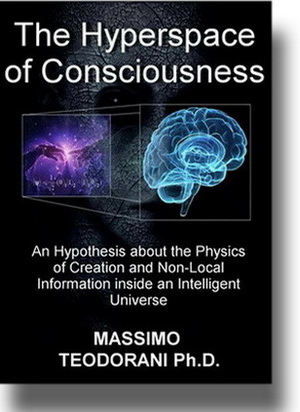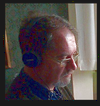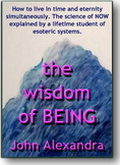 The
Hyperspace of Consciousness. Can we explain 'magic' using quantum theory? Can science and ancient
wisdom agree? Can science understand the spirit and the soul?
The
Hyperspace of Consciousness. Can we explain 'magic' using quantum theory? Can science and ancient
wisdom agree? Can science understand the spirit and the soul?
This erudite book, written by a leading Italian astro-physicist, explores the latest frontiers of spiritual and scientific thought.
 Dr. Massimo Teodorani is an Italian astrophysicist. He
obtained his degree in Astronomy and his Ph.D. in Stellar Physics at the
University of Bologna.
Dr. Massimo Teodorani is an Italian astrophysicist. He
obtained his degree in Astronomy and his Ph.D. in Stellar Physics at the
University of Bologna. As a researcher at the Astronomical Observatories of Bologna and Naples, and later at the INAF Radiotelescope of Medicina (BO) he has been involved in research on many types of explosive stellar phenomena, such as supernovae, novae, eruptive protostars and high-mass close binary stars and, more recently, in the search for extrasolar planets and extraterrestrial intelligence within the SETI Project.
He has published 17 books and many articles on quantum physics, atomic and nuclear physics, astronomy, astrophysics, bioastronomy, physics of anomalous atmospheric phenomena and aerospace subjects. He is well known to the media and has given many public presentations.
This illustrated book provides a brave and revolutionary theory of everything by a scientist prepared to look beyond current scientific dogma. Now also published in paperback.
View the Video on Youtube
or on the
My Fandalism Channel
A Buzzword eBook first release. $3.95. Use our secure Paypal shopping cart here:
Read the start of the book here:
From the
Introduction:
Standard science has established that
matter/energy and mind/consciousness are separate entities. Cartesius called
them respectively "res extensa" and "res cogitans". The present scientific
paradigm, that started with Galileo and Newton four centuries ago, assumes that
this separation is the basis of the experimental and mathematical method of
science, and of the logical reasoning of philosophy.
Certainly,
positivism, with its rigor and criteria of repeatability, has produced
irrefutable results in all fields of science and technology. For example,
classical and non-classical physics (such as relativity and quantum theories)
have been able to offer us an objective picture of reality, even if the quantum
world has taught to us that determinism is no longer valid in the realm of
elementary particles. Despite this, a mathematical description provides a sure
scientific method, even when experimental proofs are lacking.
The
Universe is written in mathematical language reflecting a system of laws, or
structure of order, inside the reality around us. And the function of a
scientist is to reveal, in an explicit and quantitative way, what Nature has
constructed. So, are science and reality ontologically the same thing? We agree
that science provides a useful, highly logical, map of reality. But we cannot be
sure that it represents the entire territoryif recurring anomalies are totally
ignored. If science continues to ignore such incongruities, it will no longer be
scientific enough and will become a dogma not so different from religion.
Unfortunately, many scientists are all too willing to accept their own canon.
This may be valid when applied to the scientific method, which no one can
question, but erroneous when applied to scientific knowledge. Except for some
totally established facts, such as classical mechanics, electrodynamics and
atomic physics, other scientific theories, for instance, the Big Bang theory and
the Standard Model for elementary particles, still wait for full confirmation.
In fact, there are different theories, equally rigorous, well able to explain
the same facts.
For instance, the stationary state theory, superstring
theory and quantum loop gravity. The former standard theories for cosmology and
structure of matter are certainly convincingin particular the Standard
Modelbecause they offer many observational and experimental evidences. But,
although their elegance and quantitative value is obvious from a mathematical
point of view, much incompleteness remains. Examples: We do not yet know if
magnetic monopoles and mini-black holes exist. We do not know exactly what is
the true component of dark matter. We are not totally sure that the neutrino has
mass. We do not know if electrons and quarks contain something else inside. We
do not know if particles are point-like objects or infinitely long strings. And,
in spite of encouraging results recently obtained, we are not totally sure that
the Higgs boson is really a field that confers mass to all the particles.
Science and physics (including astronomy) proceed by logical tiny and cautious
steps and produce numbers coming from laws that we are able to deduce from
observing reality. These laws are exactbecause formalized only by mathematics.
But are they really the territoryor simply a logical map of what we think
reality is? Our knowledge is epistemological but not yet ontological. Why?
Because, as scientists, we behave as external impartial observers and not as the
components of this reality as we live it. In other words, we describe reality as
if we are not living inside it. So what should we do in order to describe
reality better? What kind of scientific knowledge might evolve if we cease just
observing things aseptically? Certainly, the best way to be rational, as science
demands, is to remain objectivenot to identify with what we livenot to mix our
rational approach with an emotional one. However, reality is not confined to
rationality. It also involves emotions and spirituality.
There is far
more to Life than the rational mind. Certainly, rational thinking helps us
describe and understand our surroundings, including our body as a physical
entity independent from our person. But emotions and spirituality are the way we
live the reality we describe, even if not a functional method to understand
physical reality itself.
Yet they are reality as wellour own reality and
the reality of human interaction. Why shouldn't we attempt to describe our
emotions scientifically, too? The true Universe is not only made only of atoms,
stones, stars and animals but also of sentient and spiritual beings. And true
reality is a continuous interaction between a boundless landscape made of
objects and the subjects populating it, who in their turn interact together.
Therefore, reality is a much more complex entity than the one science normally
describes. We know much of that landscape, but know nothing (in exact scientific
terms) of what we truly are. You may argue that Psychology and other human
sciences describe the interiority of persons. But this kind of theorization
seems somewhat empiric, qualitative or speculative in its models. It often
borders on religion and can be irrational as well. It lacks the exactitude with
which science is able to describe external reality.
Human behavior is
unpredictable and our ignorance of what we are is clearly a major problem for
society. As the emotions of a single person or of a group of persons interacting
together are explicated inside a very specific physical landscape and not out of
it, one wonders if wider physical laws are able to describe reality in its
totality using the method of exact sciencesas physics, for instance, can. Yet we
seem to accept, from the scientific and technological results of the last 100
years, that our entire society is entirely ruled by "objective facts" and that
everything outside this limitation is irrelevant.
However, the world is
affected by a deluge of emotions of which we know scientifically only a little,
apart from their biochemistry. Consider our dreamsnot objective facts but still
part of our reality when we sleep, and sometimes also when we are awake. The
totality of a human being is made of the physical, of the intellect, of emotions
and of dreams. Is science able to describe all this? Currently it isbut
partially.
So, we have a scientific map of how we are constructed but not
yet an ontological description of what we arethat is, our true territory, which
is boundless. A "total science" should be able to furnish a descriptionable to
include both the physical and consciousness. In this book I will amply discuss
the possibility of describing consciousness and related topics scientifically.
Subsequently I will focus the attention on a new hypothesis which describes the
possibility that our consciousness is connected to a "cosmic data bank" from
which it is possible to "download" information and at the same time to "upload"
our own "data".
It will be seen in the following reasoning that this new
model of reality can explain several other phenomena, which appear to be
connected. Of course nothing of what will be said can yet be demonstrated
scientifically, as, except for some established aspects, it is mostly a sort of
logical speculation. Such a speculation is intended to be a stimulus by posing
several questions that sciencephysics in particularhasn't yet solved. Science
was not designed as a mere management of data or to perfect what we already
know, but rather as an exploration process. Only exploration can make science
evolve, because the goal of science is to acquire knowledge, which can be gained
only after some crucial and even controversial problems are fully understood in
scientific terms.
The first step towards this process is to dare to
venture a hypotheses, even the most apparently courageous. Some of such
hypotheses may eventually be unnecessar y (this can be understood only by
reasoning), but others may trigger new knowle dge. The goal of this book is to
create a stimulus both to my colleagues and to others who have the patience to
read it thoroughly. Here is no intent to present alleged "truths". There is
nothing to reveal but a series of hypotheses and fundamental questions which
might lead to a better and understanding of the reality in which we liveassuming
that what we call "mind" and "matter" are two interpenetrating and continuously
interacting entities. The intent is not to promote a philosophy or metaphysics
but a physical science.
The book has two main parts. The first deals with
the spookiest findings of quantum physics in elementary particleswith Bohm's
interpretation of quantum entanglement and his new cosmology where matter and
mind are united into a single entity through what he calls "quantum potential",
and with the most relevant theories about the possible existence of a "biofield"
and the quantum nature of consciousness and of synchronicity.
The second
partthe longestdeals with: 1) my theory about the possible existence of a cosmic
"Big Library" (BLHBig Library Hypothesis) able to link all living beings in the
Universe using non-local processes through which information is vectored and
triggering creation of new matter through the action of a hypothesized "supernal
intelligence". 2) other related topics involving the role of the "spirit"
intended as a physical and non-religious concept and the possibility that the
spirit may occupy after death bodies of non-biological nature, and finally the
search for extraterrestrial intelligence using non-local methods. Asexcept for
the first partit is based on several quite courageous hypotheses, this cannot be
considered a science book but rather a "science-fiction" text from which, one
day, true science might be born.
As explained, I am attempting here to
blow on the fire under the ash. This text is a trigger directed in particular to
my most unprejudiced and open minded scientist colleagues. After all, every
means is good that leads to a concrete result. The science expected to evolve
from this is rational, but not the close minded "rationality" of the ostrich.

